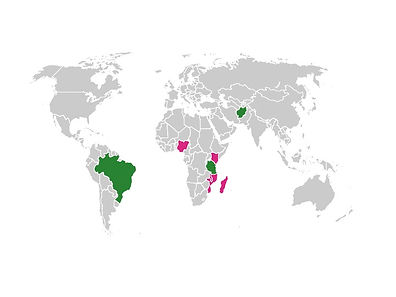Tourmaline
Name
The name tourmaline comes from the Singhalese word "turmali" (stone with mixed colors). An Egyptian legend says that the tourmaline collected all the colors as he traveled along the rainbow, and thus got his name "Jewel of the Rainbow".

Colour
The color scale ranges from colorless to pink, red (rubellite), yellow (canary tourmaline), brown, green (verdolith, chromium tourmaline), blue (indigolite), teal (Pariba tourmaline), purple (siberite), gray ( Aphritic) all the way to black. There are tourmaline in various shades that vary in intensity and tone, which is why it is also called "stone of the rainbow". In addition, it can shimmer in different colors - depending on how the light comes in. This shimmering is called pleochroism.
Particularly beautiful and popular is the green tourmaline (Verdelith) and the pink / red tourmaline (rubellite). The chromium tourmaline is an extremely rare variety of green tourmaline: it is intense green and is colored by chromium and vanadium.
Also worth mentioning are the colors of the Pariba tourmaline, which range from Caribbean Blue, Peacock Blue, Copper Green to Neona Quamarine and Turquoise Blue. The Pariba tourmaline is truly unique in its colorfulness.
Cut
The tourmaline is usually cut in different faceted forms or also in cabochon form.
Cabochon cut: This shape is an unfaceted, round or oval cut, in which the underside is flat and the top is arched outwards. The cabochon cut accentuates and enhances the shimmer inherent in the stone's structure. Those shimmers are especially vivid in cat's eye quartz, falcon and tiger's eye, moonstone and opals.
Faceted cut: There is wide variety of faceted cuts - some of them are displayed in the picture to your right.

Power
The green tourmaline is said to be patient and to promote openness and interest towards others. In addition, he also provides an overview of difficult decisions.
Birthstone
Together with the opal, the tourmaline is the birthstone of October.



Mineral group
The tourmaline belongs to the group of silicates. The mineral Elbait forms the backbone of the tourmaline gemstones, which occur in over 100 different shades.
Locations
The most important tourmaline occurrences are in Brazil and Africa. Tourmaline is mined almost everywhere in the world, including Europe, but here in insignificant quantities and qualities. Especially sought after is the Paraiba tourmaline, with the intense blue (green) color, it was first discovered in the late 80s in a mine in the Brazilian state of Paraiba, from where he got his name.


Mohs scale
The Mohs hardness describes the hardness of a mineral on a scale of 1 to 10 and is named after its inventor, the German mineralogist Friedrich Mohs (1773 - 1839). It is the basis of the hardness test. Friedrich Mohs scored various minerals against each other and arranged them according to their hardness. The scale consists of a series of 10 minerals, each of which "scratches" all standing in front of him. Diamonds have a Mohs hardness of 10 and are therefore the hardest minerals.
-
1 + 2 can be scratched with the bare fingernail
-
1 - 5 can be scratched with the knife
-
6 - 10 can be scratched with pane
The tourmaline has hardness 7-7.5 on the Mohs hardness scale.
Care
The best way to care for the tourmaline with warm, soapy water and a soft cloth. Tourmalines may be cleaned with steam, but not with ultrasound.


Combination
The tourmaline has so many combination possibilities. Alone, its color spectrum with up to 100 shades make it possible to wear a different combination every day. My favorites are the green tourmalines paired with yellow gold or a pink tourmaline with rose gold. The best way to wear the Pariba tourmaline is with an elegant white gold.